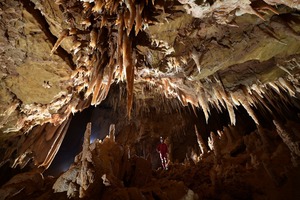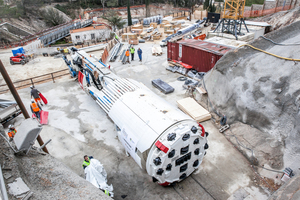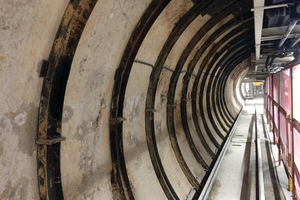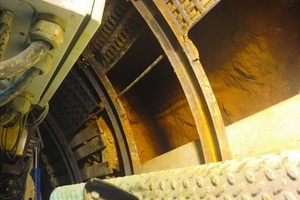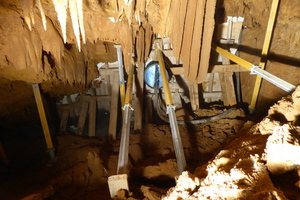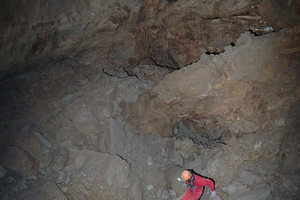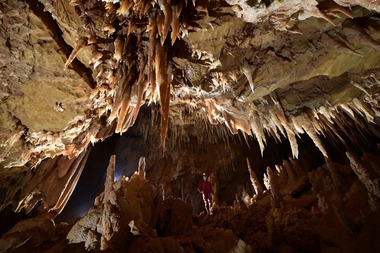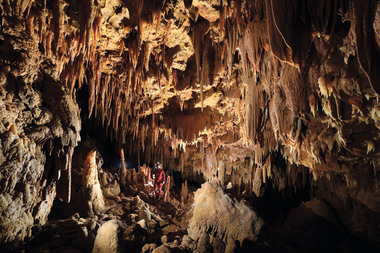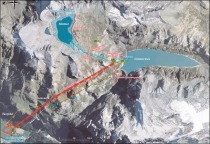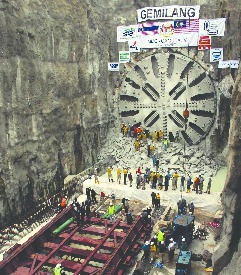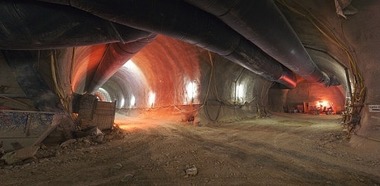Overcoming Multiple Caverns: Successful TBM Tunneling in Karstic Geology at Galerie des Janots
In April 2019, a 3.5 m diameter open-typ, Main Beam TBM and its crew broke through at the Galerie des Janots Tunnel in La Ciotat, France. The 2.8 km long tunnel, excavated in limestone known to have groundwater, karstic features, and voids, took two years to complete due to challenges including two uncharted caverns -- the largest of which measured a staggering 8000 m³ in size (Fig 1).
Upgrading the Water Supply
Galerie des Janots is one of the 14 operations designed to save water and protect resources, which are being carried out by the Aix-Marseille-Provence metropolis, water agency Rhône Mediterranean Corsica, and the French State Government. The Janots gallery will improve access to water in the communities east of the Aix-Marseille-Provence metropolis (Cassis, Roquefort-la-Bédoule, La Ciotat and Ceyreste). The future pipeline will replace existing pipelines, currently located in a railway tunnel, that have significant safety and vulnerability deficiencies with estimated water losses of 500 000 m³ per year. The current pipes have a capacity limited to 330 liters per second, which is largely insufficient in the summer months. The objective of the operation is to increase capacity to 440 liters per second. According to Danielle Milon, Mayor of Cassis, “This is an investment of 55 million euros with 11 million in aid from the water agency. This project required 10 years of reflection and work to improve water supply. And water is essential for the development of each municipality, and for citizens’ well-being.”
The tunnel passes under Le Parc National des Calanques, with cover between 15 and 180 m. Geotechnical studies of the area showed limestone, with the possibility of both filled and empty karst caverns.
A Launch in Limited Space
The 3.5 m diameter Robbins TBM, christened “Augustine”, was commissioned on March 3, 2017. The TBM was extensively modernized and upgraded during the rebuild for the Galerie des Janots project in La Ciotat. At 250 metric tons, and 135 m long, the TBM and back-up system could not fit at the small jobsite abutting residences and other buildings (Fig. 2). “Very little on-site storage was allotted in the launch area, with just 25 m outside the portal for assembly – the exact length of the TBM from the head to the rear legs. The logistics of the machine arriving in sequence and being assembled on time was vital,” explained Robbins Field Service Supervisor Andy Birch, who assisted contractor Eiffage during the TBM assembly. “We did a two-stage assembly. First we assembled the TBM and five decks of the back-up system, then we did the remaining decks.” After assembly, the crew launched the machine, working 24 hours a day to excavate the tunnel and maintain equipment during the bore.
Excavating in Tough Ground
At the machine’s launch, the crew was optimistic about getting through the obstacles presented by karstic limestone. “Limestone is an easy rock to dig, but one can be confronted with the phenomenon of karst,” said Loïc Thévenot, Director of Underground Works for Eiffage during the TBM launch. “For this purpose, the tunnel boring machine is equipped with a probe drill. If the karst is small, we will fill it with concrete. If it is large, we plan to erect a small parallel gallery.”
To further identify cavities ahead of the TBM, the crew installed a geotechnical BEAM system, standing for Bore-tunneling Electrical Ahead Monitoring. BEAM is a ground prediction technique using focused electricity-induced polarization to detect anomalies ahead of the TBM.
Despite all the preparation, ground conditions were particularly tough in the first 1000 m of boring. The crew encountered limestone with powdery clays, but this became an obstacle when groundwater was added to the mix. “In some areas we encountered water-bearing rock that turned the material into a sticky clay. This caused the cutterhead to block, though thankfully not for a great distance. We were able to unblock the cutterhead manually using a clay spade and shovel,” said Birch. The crew could tell when blocking occurred due to torque spikes on the cutterhead and reduced muck on the conveyor belt. “We reduced water sprays through the cutterhead to avoid creating stick clay,” continued Birch.
While at the site, Robbins Field Service advised and gave instruction regarding technical issues and operational functions of the TBM, as well as instructed on maintenance and ways to sustain good advance rates. The weak rock and clay conditions necessitated ground support including resin-anchored bolts and rings in bad ground, topped with wire mesh and a 10 to 15 cm thick layer of shotcrete (Fig. 3). Some small filled and empty karst cavities were encountered (Fig. 4), and these were systematically drained if needed and filled with grout or foam.
The first Cavern
At the 1035 m mark, the crew hit a cavern on the TBM’s left side. The cavern, studded with stalactites and stalagmites and measuring 8000 cubic meters in size, was grazed by the TBM shield (see Fig. 1). The crew named the cavern “grotte Marie Lesimple” after their site geologist.
“We hit the corner of it. To cross it, we had to erect a 4 m high wall of concrete so the TBM would have something to grip against,” explained Marc Dhiersat, Project Director of Galerie des Janots for Eiffage (Fig. 5). A small door allowed access inside the cavity, which had formed naturally at a point 60 m below the surface. The TBM was started up again and successfully navigated out of the cavern in eight strokes without significant downtime to the operation. The process took about two weeks.
“This is certainly unusual, to come across a cavern of this size and significance. It is somewhat related to the geology, with karstic and volcanic formations having the most potential for underground cavities,” said Detlef Jordan, Robbins Sales Manager Europe. Karst cavities were a known risk during the bore, but the cavern was not shown in vertical borehole reports or in the geophysical survey conducted from the surface along the alignment.
A second Cavity below the Tunnel Path
After clearing the cavern the ground stabilized. The machine averaged excavation rates of 20 to 22 m per day in two shifts, with a dedicated night shift for maintenance. Crews ran the excavation five days per week, achieving over 400 m in one month. This performance continued until the 2157 m mark, when the machine grazed the top of another unknown cavity that extended deep below the tunnel path. This structure measured 22 m long, 15 m wide, and 14 m deep, or about 4500 m³ of open space (Fig. 6).
Crews probed in front of the cutterhead and began work to stabilize and secure the cavity with foam and concrete, as well as excavate a bypass gallery. “After filling much of the cavity – about 1500 m3 – our biggest difficulty was to ensure the gripping of the machine: We needed six bypass galleries and four months of work to reach the end of this challenge,” said Dhiersat. For the last 600 m of tunneling, “we were finally in good rock,” he emphasized. Overall rates for the project averaged 18 m per day in two shifts, and topped out at 25 m in one day.
“The cooperation with Marc and his team on site was very good and we always enjoyed their professionalism and commitment to the project and the task. This, without any doubt was key for the success we jointly achieved,” said Jordan. “For us, it was satisfying and motivating to see that, by working together and joining the efforts of all partners on the project, the best and most successful outcome can be achieved. This commitment for decades has been at the heart of success in the tunneling industry, but it has not always been observed on other recent projects.”
While Galerie des Janots has been a tunnel full of obstacles, the lessons learned have been invaluable. The crew was able to pick up on anomalies around the TBM in time to deal with them safely, and they have successfully put to the test methods to extract a TBM after encountering caverns and karsts, getting the operation moving again. “We are proud to have led a motivated and conscientious team to the end of the tunnel who worked well without accidents despite the many technical difficulties encountered,” said Dhiersat.

